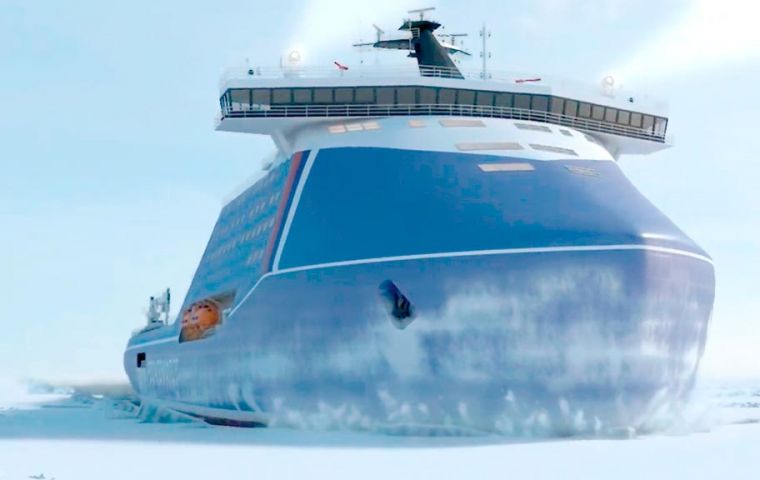MercoPress. South Atlantic News Agency
Russia building 69,700-ton nuclear powered icebreakers to keep the Northern Sea Route navigable year round
 Planned Rosatom icebreaker fleet positioning by 2035 with 100 million tons of cargo. (Courtesy of Rosatom)
Planned Rosatom icebreaker fleet positioning by 2035 with 100 million tons of cargo. (Courtesy of Rosatom) Russia pushes ahead with plans to ensure year-round navigation along the Northern Sea Route. The Leader-class icebreaker also referred to as LK-120Ya, will be twice as powerful as the country’s current nuclear icebreakers.
The vessel will use two RITM-400 type nuclear reactors to power four propellers with 30 MW capacity each. With a total displacement of 69.700 tons it will also be more than twice as heavy as Russia’s newest and currently largest icebreaker, Arktika.
The vessel is designed to break channels as wide as possible through the sea ice for oil and gas tankers to follow in its wake. To this end the Leader-class is nearly 48 meters wide, 13 meters more than current icebreakers. With massive amounts of power and its large weight the vessel will be able to break through up to four meters of ice, compared to 2.3 meters for the current Arktika-class.
“The commissioning of this atomic icebreaker will enable Rosatomflot to ensure safe and regular operations in the eastern region of the Arctic, provide year-round navigation in the waters of the Northern Sea Route, and open up new opportunities for commercial high-latitude routes,” says Rosatomflot’s general director Mustafa Kashka.
According to the contract signed between Rosatomflot and Zvezda shipyard the vessel is planned to be commissioned in 2027, with two additional icebreakers of the type to follow by 2033.
This timeline may end up being too ambitious in light of the fact that the Arktika-class, of which Russia is currently building five vessels, has faced several delays and technical challenges. Construction on the class’ lead vessel Arktika began back in 2013 and the vessel has yet to be placed into service.
Originally Arktika was supposed to be delivered by December 2017 but due to problems with domestically-sourced components of the steam turbines the vessel was delayed nearly two years. After the ship began sea trials earlier this year it was revealed that one of its propulsion motors suffered irreparable damage during a short circuit requiring a complicated and lengthy replacement of the motor next year. The repair involves cutting through the hull of the ship to remove and replace the 300 tons unit.
While the ship could operate with reduced engine power until a repair can be done in 2021 experts now recommend that the vessel not leave the Baltic Sea as it will have to return to the Baltic shipyard at St. Petersburg next summer.
The Leader-class will be constructed by the Zvezda shipyard in Far East Russia near Vladivostok. The shipyard has seen recent expansion but has until now been unsuccessful in securing contracts for nuclear icebreakers. The contracts for all five Arktika-class icebreakers went to the Baltic shipyard. Zvezda also aims to build ice-capable LNG carriers for Novatek, but recently lost a bid to Samsung Heavy Industry of South Korea. Construction of the world-largest nuclear icebreaker undoubtedly represents the most complex vessel built by the shipyard.
The concept for a massive 120MW nuclear icebreaker escorting ships through the thick ice of the East Siberian Sea during the heart of winter goes back as far as the early 1990s. The idea and the need for larger icebreakers gained traction over the past decade as companies such as Novatek and Rosneft began exploiting natural resources in the region and transporting them along the NSR.
Currently, the companies’ ice-hardened oil and gas carriers can routinely travel to Asia only during Summer and Fall. During winter the ice still proves too challenging. The Leader-class’ ability to break up to 2.5 meters thick ice continuously at 10 knots, a capability the current fleet of icebreakers lack, will be key to ensuring reliable and speedy escorts for commercial vessels during winter.




Top Comments
Disclaimer & comment rulesCommenting for this story is now closed.
If you have a Facebook account, become a fan and comment on our Facebook Page!